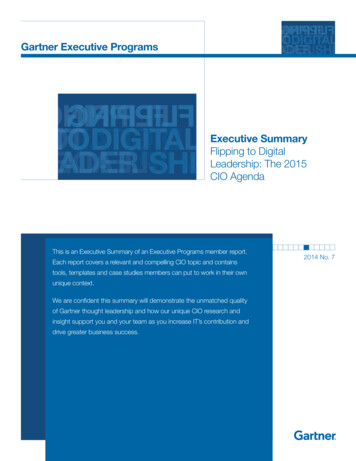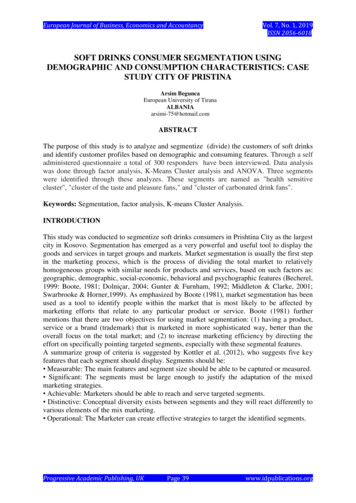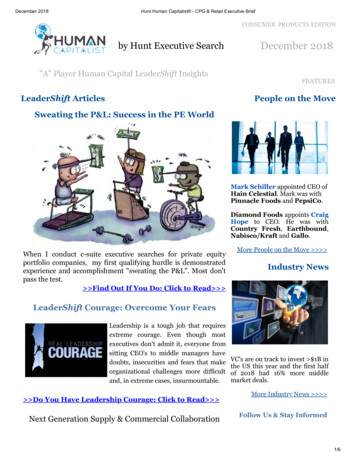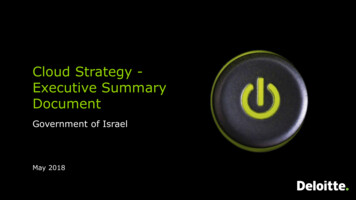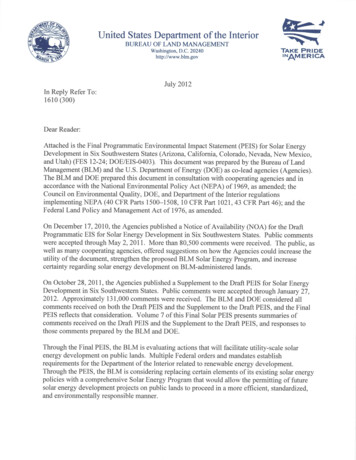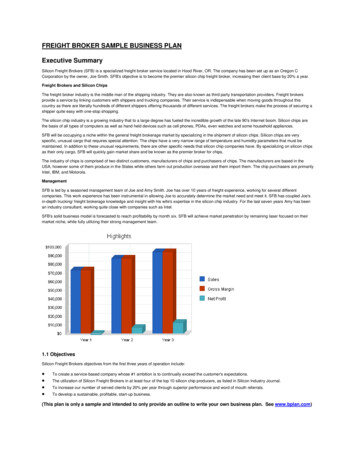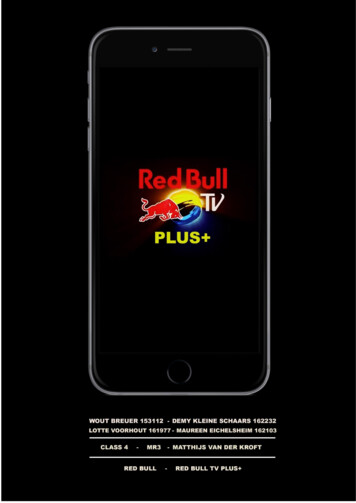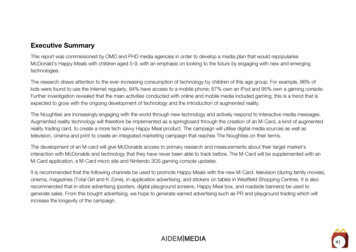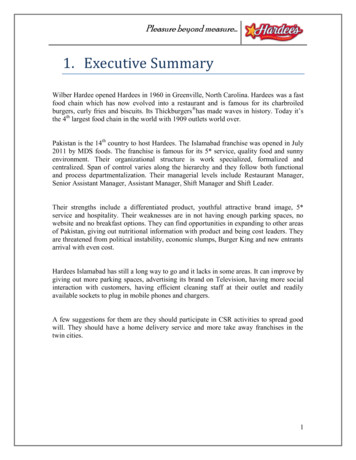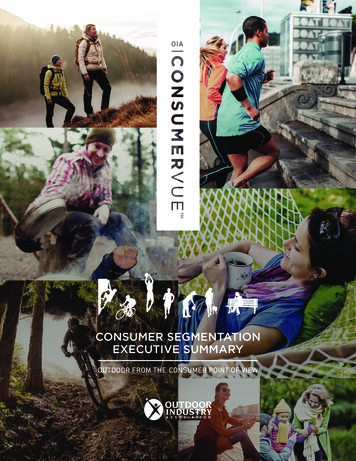
Transcription
CONSUMER SEGMENTATIONEXECUTIVE SUMMARY1
INTRODUCTIONThe ethos of the outdoor industry, built from within, has always thrivedon the epic adventures, pushed limits and shared interests of an intimatecommunity of passionate enthusiasts. While this spirit lives on for some in thenext generation of outdoor participants, there are many who choose far moresimple and diverse ways to love the outdoors and play in it. Their choices foroutdoor activity, driven by factors such as where they live, how they grew up,and current lifestyle limitations, cast new meaning on the traditional industrydefinition of outdoor recreation.With this in mind, the ability to serve both the core and broader communitiesof outdoor participants is critical to the continued success and growth of theoutdoor industry. To be relevant to the next generation of outdoor participants,we must better understand their desires, attitudes and behaviors. That need forunderstanding leads us to the central purpose of this research: to understandoutdoor from the consumer point of view.This report sheds light on those viewpoints with key findings from our outdoorconsumer segmentation study. Among the segments explored here, we expectyou will recognize a few, while others may be surprising. Even among familiarconsumer segments, there are some interesting revelations. The world is changingquickly, and with it, outdoor consumers are changing how they shop, how theythink about brands, and how they engage with the outdoors.These findings are based on a wealth of data, only a fraction of which is presentedhere. Additional results, reports, and tools will be made available over the comingmonths through OIA ConsumerVue, an online interactive research tool tohelp industry members understand outdoor from the consumer point of view.Throughout this report and within OIA ConsumerVue, you will find specialemphasis placed on specific, actionable business opportunities. We believe thathighlighting these strategies, distilled directly from consumer insights, will benefitoutdoor industry members today and well into the future.BACKGROUNDOutdoor Industry Association conducted an outdoor consumer segmentationstudy in 2014, through qualitative and quantitative research efforts, to meet thefollowing objectives:· Understand how the general U.S. population defines outdoor and how theyengage in outdoor activities· Quantify the outdoor consumer market in terms of size and spend· Identify distinct segments of outdoor consumers in the marketplaceThe resulting data identified macro-level insights on the U.S. outdoor consumermarket, as well as revealed distinct attitudinal segments of outdoor consumers.While the segments may favor particular activities or share similarities in activitylevels or demographics, the distinguishing variables used to identify the segmentswere based on the consumers’ motivations and hindrances to getting outside, aswell as their attitudes about the outdoors.2
THE OUTDOORCONSUMER MARKETMIDWESTSAMPLE 21%CENSUS 22%NORTHEASTSAMPLE 19%CENSUS 18%WESTSAMPLE 24%CENSUS 23%60%SOUTHKEY INSIGHTSThirty-four percentof outdoor consumerslive in cities, and thoseconsumers tend to beyoung, ethnically diverse,active, and spend the moston outdoor gearSeventeen percent ofoutdoor consumersare Hispanic – one ofthe fastest growingdemographic groups inthe countryKEY INSIGHTSActivities, products,and services that helpaging consumersstay engaged in theoutdoors and helpparents get their kidsoutdoors within timeand budget limitationswill keep the currentmarket of outdoorconsumers healthyand fill the pipelinefor the futureSAMPLE 36%CENSUS 37%In the United States, there are 198 million adults between the ages of 18-65 and ofthose, 60 percent qualify themselves as outdoor consumers. Outdoor consumers aredefined as people who:· Spend at least one hour per week outdoors· Participated in traditional or non-traditional outdoor activity at least once in thepast year· Purchase apparel, footwear, equipment, and/or technology for outdoor activitiesDemographically, outdoor consumers look much like the U.S. population andrepresent a broader market of people outside and being active than historicallytargeted by the outdoor industry. About half are female, almost half are 25-44 yearsold, over one third are minorities, and one third live in the South.Outdoor consumers are looking for ways to stay active in their everyday lives.More than one third of them report that they used to be more active, but they stillsee themselves as being active into old age. More importantly, over 30 percentare interested in trying new outdoor activities and report that they are making aconsiderable effort to spend more time outdoors.Forty-three percent of outdoor consumers have kids at home, and they believe theyare raising the next generation of outdoor consumers. Most report that they believeit is natural for kids to spend time outdoors and that they encourage their kids to doso for their health and well-being.3
Outdoor consumers do not classify themselves as especially outdoorsy (see Figure 1),despite the fact that most participate in traditional outdoor activities like swimming,running, road bicycling, and day hiking, which rank at the top of the list. That said,they have a very broad definition of what it means to engage in the outdoors. Infact, nearly all outdoor consumers participate in non-traditional outdoor activities,most common include relaxing outside, barbecuing/picnicking, walking forenjoyment, and walking for a purpose.28%21%Figure 1: Self-ReportedLevels of “Outdoorsiness”8%9%4%NOT OUTDOORSY AT ALLKEY INSIGHTSOutreach efforts thataddress universal needssuch as sunshine/freshair and social engagementwill resonate with nearlyall outdoor consumers11%20%EXTREMELY OUTDOORSYOutdoor consumers are motivated by a variety of different factors that range fromactive to leisurely. The top-rated motivations for getting outdoors were the positivebenefits of sunshine and fresh air, to spend time with family, and to have fun. Onthe other hand, there are surprisingly few barriers. Only 11-12 percent of outdoorconsumers endorse the top barriers, which include the amount of free time theyhave available and the cost of some outdoor activities.Outdoor recreation is fundamentally social for today’s consumers. Friends,significant others, and kids are the key influencers in getting people outside. Theseare also the people with whom they most often engage in outdoor activities. Only20 percent of outdoor consumers participate by themselves.Seventy percent of outdoor consumers use technology for something outdoorrelated, and many of those use it to make their outdoor experiences even moresocial. Those who use smartphones in the outdoors use them to stay in touch, andthose who use Facebook or Twitter do so to share their outdoor experiences withothers. YouTube is most often used to find inspiration or learn about a new outdooractivity, and Google is used to find new places to engage.KEY INSIGHTBrand familiarity is higherfor athletic brands thantraditional outdoor brandswith Nike and Adidas,leading the packWILLING TOPAY MORE FORIS DURABLE46%IS THE HIGHESTQUALITY42%MAKES ME FEELCOMFORTABLE42%Purchase attitudes among outdoor consumersThe average outdoor consumer spends 465 annuallyon apparel, footwear, equipment, and electronics fortheir activities. While price ranks high in importance,function and versatility are key purchase influences.Many outdoor consumers have a “good is good enough”mentality towards outdoor products, citing that theydon’t need the best gear or equipment on the market.Durability, quality, and comfort are product attributesthat many consumers are willing to pay more for.OUTDOORGADGETS 81 / 18%OUTDOORAPPAREL 137 / 30%AVERAGEANNUALTOTALSPEND 465OUTDOORFOOTWEAR 123 / 26%OUTDOOREQUIPMENT 123 / 26%Outdoor consumers shop with a purpose. This is not tosay that impulse purchasing doesn’t happen, but 75 percent of consumers shoppingfor outdoor products are shopping with intent. The types of channels throughwhich they shop most often include mass merchants, sporting goods chain stores,outdoor stores, and general online retailers.When choosing a retailer, price tops the list, but selection, convenience andproducts for the entire family are on par. Technology plays an important rolein the shopping process. More than 20 percent of consumers use technology toread product reviews or compare prices. Just under 20 percent use technologyto discover new brands or find new places to shop. Google is the second mostfrequently visited website/search engine and is most often used to compare pricesand read reviews.4
POPULATION OFOUTDOOR CONSUMERSSEGMENTS OFOUTDOOR ANATHLETETHESIDELINERTHECOMPLACENTThe seven segments of outdoor consumers paint a vivid picture of just how diversethe market is. Representing a broad range of participation and purchase behaviors,each segment offers different opportunities for outdoor businesses.5
The chart below shows the percentage of outdoor consumers in each segmentcompared to the percentage of outdoor spend represented by each segment.For example, 10 percent of the outdoor consumer population is The Achiever,and these consumers represent 17 percent of the outdoor spend. Assumingthat each person represented an equal proportion of spend, we would expectThe Achiever to account for 10 percent of spend, however they over-index by7 percent, making them a valuable segment when measured by spend alone.Likewise, The Outdoor Native over-indexes on spend by 4 percent and TheUrban Athlete by 13 percent.OUTDOOR T14%4%4%Charts in this report may not always add up to 100 percent exactly.This is a result of rounding errors that do not persist in unrounded data6
THEACHIEVERThe Achiever best represents the traditional outdoor consumer. Theyparticipate in a number of different activities including team sports,running, camping, climbing, and mountain biking, among others. Membersof this segment are driven to participate in outdoor activities by a varietyof motivations including performance and competition. Those that don’tparticipate at a professional level aspire to do so, and nothing stands in theway of getting outdoors for members of this segment.“ I do basically everything outside, such asplaying sports, fishing, biking, running,and swimming.”The Achiever wants the best products on the market with respect to styleand function, regardless of brand or channel. They embrace technology in allaspects of their lives and use it to track their performance in outdoor pursuits.“My jobs andinterests require meto be outside. I lovehiking, fishing,and camping.”The Achiever tends to be a younger male with children at home. They aremore likely than members of other segments to live in or near a city and aremore ethnically diverse.KEY OPPORTUNITYBy virtue of their participation and attitudes, members of TheAchiever segment represent the quintessential outdoor consumer.Yet, they don’t exhibit much brand loyalty and tend to value stylein addition to function. As they are very social, they can be leveragedto inspire others in the outdoors.7
THEOUTDOOR NATIVEGetting outside has always been an important lifestyle choice for The OutdoorNative and will continue to be in the future. They are motivated by enjoymentand the experience. Although they want to improve their own performance, theyare less concerned about competition than their counterparts, The Achiever.They balance their personal passions in traditional outdoor activities with moreleisurely family-oriented activities including playing outside, running, cycling,day hiking, and camping. They want to spend more time outside, particularly withtheir families. Not much stands in the way of getting outside for members of thissegment, except occasionally the amount of free time available to them.“ I try to spend as much time outside as I can.It doesn’t matter if it’s yard work, running,hiking, or just relaxing.”“I love beingoutside in thesun, in the rain,in the snow—all weatherconditions.”The Outdoor Native seeks sensible products that can cross activities, with a priorityon versatility, functionality, and affordability. They mix traditional outdoor brandswith more mainstream athletic brands. The Outdoor Native values technology butuses it more to discover and inspire their pursuits, preferring to disconnect whilethey are actually outdoors.The Outdoor Native is more likely than members of other segments to be amiddle-aged male.KEY OPPORTUNITYThe Outdoor Native is highly engaged, will continue to be engaged,and is grooming the next generation of outdoor consumers. The keyopportunity lies in connecting these consumers with your brand/business and leveraging their influence on the next generation.8
THEURBAN ATHLETEThe Urban Athlete represents significant opportunity for the outdoor industry.The Urban Athlete gets outside not because they love the outdoors but because theactivities they enjoy require them to go outside. Getting outside ranges from goingto parks, the gym, and basketball courts all the way to mountains and lakes. Theyparticipate in activities such as basketball, skateboarding, outdoor yoga, mountainbiking, races, and drills/HIIT/CrossFit. They were raised on team sports and, as aresult, getting outside is much more about competition, socialization, and intensitythan it is about connecting with nature. They feel crunched for time which is asignificant barrier to increasing their engagement with outdoor activities.“ I like the outdoors and getting out, but mylifestyle doesn’t allow it so much.”The Urban Athlete favors athletic products and brands and tends to be very styleconscious.
represent a broader market of people outside and being active than historically targeted by the outdoor industry. About half are female, almost half are 25-44 years old, over one third are minorities, and one third live in the South. Outdoor consumers are looking for ways to stay active in their everyday lives.
